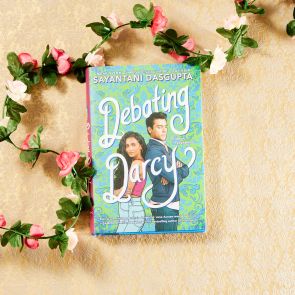 “For all the brown girls who dreamt of gossamer gowns/Only to realize we were already wearing crowns/(And for Colin Firth. For reasons that I hope are obvious),” reads the dedication to Sayantani DasGupta’s latest young adult novel published with Scholastic, Debating Darcy.
“For all the brown girls who dreamt of gossamer gowns/Only to realize we were already wearing crowns/(And for Colin Firth. For reasons that I hope are obvious),” reads the dedication to Sayantani DasGupta’s latest young adult novel published with Scholastic, Debating Darcy.
Debating Darcy is a modern retelling of Jane Austen’s 1813 classic Pride & Prejudice, the iconic tale of the rollercoaster relationship between Elizabeth Bennet, the daughter of a country gentleman, and Fitzwilliam Darcy, a rich aristocratic landowner. “As a huge Jane Austen fan, I always go back to Pride & Prejudice when things are rough,” says Sayantani about her inspiration for the book. “I had also, in the back of my mind, wanted to do a reimagining with multicultural characters,” she explains. “It was the book I needed to read in a difficult time, so I ended up writing it.”
In Debating Darcy, Leela Bose, playing the part of Elizabeth Bennett’s character, is an Indian American high school student and lifelong speech competitor. When Leela meets Firoze Darcy (who is our modern Mr. Darcy), a Pakistani American know-it-all debater with a hard demeanor from an elitist private school, Leela has no choice but to try and tolerate him. This is because his school is included in the state league she’s competing in and their paths will inevitably cross. But when push comes to shove and tensions arise, (spoiler alert!) Leela and Firoze find themselves falling for each other, just like Elizabeth and Fitzwilliam in Pride & Prejudice.
It seems natural for Sayantani to have written opposing speech and debate teams to mirror Jane Austen’s cast of characters, but in a more modern and realistic way. “It was really important to me to represent the world we live in. The world we live in has people of all sexualities and backgrounds,” says Sayantani. For example, Jane in Pride & Prejudice becomes Jay, Leela’s Filipino-Dominican best friend who is infatuated with Charles Bingley, a wealthy member of Firoze Darcy’s speech team. Lidia and Kitty are both younger members of Leela’s team and take on identities of their own, whereas in Pride & Prejudice they play Elizabeth’s younger sisters, whose fates are entwined with the rest of the Bennett sisters. Tomi Lucas, the Nigerian American president of Leela’s speech team and Charlotte Lucas’ parallel, ends up with Colin Kang, the Korean American, overdramatic vice president of the team and Williams Collins’ likeness. Each character in Debating Darcy has a Pride & Prejudice counterpart, but with a twist.Pride & Prejudice is one of the most popular novels in English literature, and has inspired many retellings in modern literature and media. For over 100 years, dramatic adaptations, reprints, unofficial sequels, movies, and television versions of the original text have portrayed the memorable characters and themes of the novel. “I think retellings of well known stories do many different things,” says Sayantani about why she chose to rewrite a classic. “I think they allow us to revisit our old favorites – stories we’ve grown up with or read so many times that they are a part of our DNA. Whether it’s Austen, Shakespeare, or Brontë, I think revisiting these old stories that are so much a part of our personal and collective consciousness allows us to introduce them to new readers and serve as a gateway, but also allows us a chance to rewrite and critique those parts that maybe don’t hold up as well in a modern context going forward.”
A great example of this is Lydia’s character. In Pride & Prejudice, Lydia Bennett is whisked away to be married at the risk of the societal status of her family by John Wickham, a dishonorable gentleman who has proven himself unreliable. “I, like most readers, don’t like Lydia Bennett – she’s selfish and she puts the future of her sisters at risk by behaving in unsafe ways,” says Sayantani. “But if you put that character in a modern era, you realize this is a young woman, who is a bit brash and empowered in her own sexuality. But is that such a bad thing? Or is it the fact that society tells her she shouldn’t behave in these ways?” Which is why in Debating Darcy, Lidia's character takes on a whole new purpose when she enters her problematic relationship with Jishnu – Wickham’s parallel. When Lidia handles herself and the unsafe situation she gets into with Jishnu, it becomes an empowering moment for her character. Lidia shows us that we can’t let people like Jishnu off the hook, and we can’t blame women for the misogynistic and advantageous behavior of people like the Jishnus (and Wickhams) of the world.
While these parallels take old world problems and themes and make them have new meaning with a modern context, they also bring to light the question of why we feel comfort in revisiting stories like Pride & Prejudice. “We as human beings tend to revisit the same old tales… about family duty, or love, or what are our roles in the world – but we’re constantly making them our own. We’re putting them in conversation with our own politics, ethnic backgrounds, and personal circumstances. That’s the way these stories stay alive,” says Sayantani.



